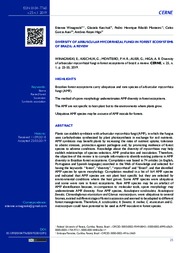Diversity of arbuscular mycorrhizal fungi in forest ecosystems of Brazil: a review.
Diversity of arbuscular mycorrhizal fungi in forest ecosystems of Brazil: a review.
Author(s): WINAGRASKI, E; KASCHUK, G.; MONTEIRO, P. H. R.; AUER, C. G.; HIGA, A. R.
Summary: Plants can stablish symbiosis with arburcular mycorrhiza fungi (AMF), in which the fungus uses carbohydrates synthesized by plant photosynthesis in exchange for soil nutrients. AMF symbiosis may benefit plants by increasing the rates of nutrient uptake, tolerance to abiotic stresses, protection against pathogens and, by promoting resilience of forest species to adverse conditions. Knowledge about the diversity of mycorrhizas may help stablish relationships of species selection, AMF production and inoculation. Therefore, the objective of this review is to compile information to identify existing patterns in AMF diversity in Brazilian forest ecosystems. Compilation was based in 74 articles (in English, Portuguese and Spanish languages) searched in the Web of Knowledge and selected for having the keywords ?forest?, ?diversity?, ?mycorrhizal? and ?Brazil?, and that identified AMF species by spore morphology. Compilation resulted in a list of 164 AMF species and indicated that AMF species are not plant host specific but they are selected by environmental conditions where the host grows. Some AMF species were ubiquitous and some were rare in forest ecosystems. Rare AMF species may be an artefact of AMF identification because, in comparison to molecular tools, spore morphology may underestimate AMF diversity. Four AMF species, Acaulospora scrobiculata, Acaulospora foveata, Clareoideglomus etunicatum and Glomus macrocarpum, were ubiquitous to several biomes, existed in different stage of forest succession and seemed to be adapted to different forest managements. Therefore, A. scrobiculata, A. foveata, A. mellea, C. etunicatum and G. macrocarpum could have potential to be used as AMF inoculant in forest species.
Publication year: 2019
Types of publication: Journal article
Unit: Embrapa Forestry
Keywords: AMF, Bioma, Floresta plantada, Micorriza, Mycorrhizal fungi, Planted forest, Succession, Symbiotic association
Observation
Some of Embrapa's publications are published as ePub files. To read them, use or download one of the following free software options to your computer or mobile device. Android: Google Play Books; IOS: iBooks; Windows and Linux: Calibre.
Access other publications
Access the Agricultural Research Database (BDPA) to consult Embrapa's full library collection and records.
Visit Embrapa Bookstore to purchase books and other publications sold by Embrapa.

